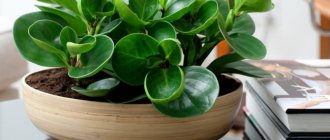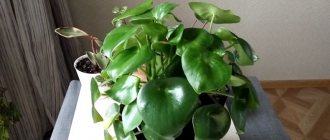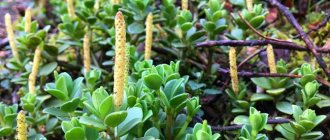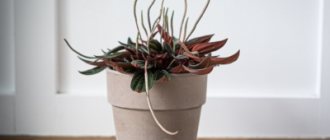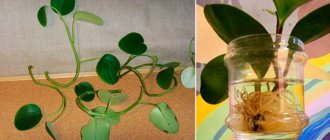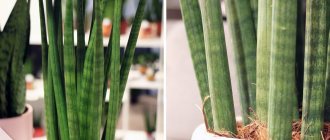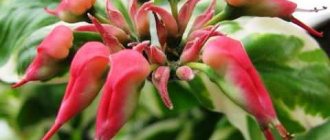What does a flower look like
The plant belongs to the Pepper family. Its veins seem to be recessed, and the leaf itself seems slightly swollen. The color comes in different shades of green with a mottled and waxy coating. The plant is native to South America.
Spectacular flower appearance
For your information! The Lilian species can grow up to 32 cm in height. It is used to create ampel compositions. Small pots are hung or placed on the windowsill.
The prevalence of the flower is due to the fact that it is resistant to dry soil or excessive watering. The perennial does not need frequent feeding.
Botanical description
Peperomia caperata, one of the many species of the genus Peperomia from the Pepper family. The name of the genus - “Pepper-like” - is due to the fact that the leaves of peperomia, when crushed, emit the smell of pepper. In English-speaking countries, peperomia is called “Radiator plant” - “Radiator flower” and “Baby rubber plant” - “Little ficus”.
Peperomia caperata (or Peperomia corrugata) gets its name from its wrinkled leaves. As for the Lilian variety, its name was given because of the distant similarity of the inflorescences to lily flowers. Like most varieties of peperomia, Lilian arose naturally, without the efforts of breeders.
The flower was officially described only in 1958, although it was already known in indoor floriculture in both Europe and America. American botanist T. J. Yanker, a specialist in the Pepperaceae family, was unable to trace the origin of the species and used a herbarium specimen.
Peperomia Lilian is a low herbaceous plant, rarely exceeding 30 cm in height. The leaves are emerald green and heart-shaped. On the reverse side the shade is lighter.
The resemblance of Peperomia Lilian flowers to lilies is only external. In fact, on each long brownish-red peduncle, not one, but many small flowers bloom, collected in a spadix. The cob is wrapped in a snow-white covering leaf with a bell at the end. The bell is usually located at an angle to the main part of the inflorescence. It is this covering leaf that resembles a lily flower. The plant is native to the rain forests of Brazil.
Features of caring for Peperomia Lilian
Caring for a plant is not difficult, but you need to familiarize yourself with the basic growing criteria, find out at what temperature to keep the crop, and how to irrigate it.
Temperature
Peperomia watermelon - home care
Due to the tropical origin of the flower, it loves warmth and does not tolerate drafts. In spring and summer, the optimal temperature is 20-22 °C. In winter, the indicator should not fall below 16 °C.
Lighting
The main condition is that the perennial should not be exposed to direct sunlight, so it is best to grow flowers on the windowsills of the eastern and western rooms.
Important! If the side is south, then you will need to create a shadow or place the pot deeper into the room.
In winter, it is necessary to create artificial lighting. This is achieved through the use of electric lamps. They extend daylight hours.
Also, in the cold season, the perennial needs protection from drafts, but in the summer it can be taken out into the air. With darkening, the crop is brought into the room, since low temperatures and cool winds will harm the plant.
Watering
Watering depends on the time of year. During the growing season, increased irrigation must be provided. It is better to choose soft, settled water without precipitation at room temperature. In winter and autumn, watering is reduced. During this period, the flower tolerates a lack of moisture better than excess irrigation.
Excessive watering leads to the development of fungal diseases. But watering from time to time is simply necessary so that the leaves do not fall off from lack of water.
Important! In summer you can spray the leaves with a spray bottle. This will help wash away dust and give the flower freshness.
Humidity
Home culture does not require creating high humidity in the room. It grows well with or without spraying. The plant develops equally well in dry and humid areas.
Priming
When choosing soil for growing Peperomia Lilian, you need to consider the following criteria:
- the substrate must allow air to pass through well and not clump;
- the soil should not retain excess moisture.
Universal earth
To grow a perennial at home, a gardener can choose one of the following mixtures:
- 2 parts leaf soil and 1 part each sand, humus and peat;
- a mixture of leaf, peat soil and sand, the mass is taken in the same quantity.
Important! Soil acidity should be between 5.5 and 6.5 pH.
Feeding
In order for the flower's leaves to remain bright throughout the year, it needs nitrogen-based fertilizers. Ready-made fertilizers for ornamental plants are suitable, containing not only this element in the required quantity, but also other useful substances: manganese, potassium, phosphorus and boron. Peperomia loves organic matter.
In spring and summer, it is recommended to alternate feeding with mineral and organic compounds. They are applied once every two weeks. In winter and autumn, fertilizers are needed, but in limited quantities. The concentration is reduced and the intervals between application and irrigation are increased.
Bio fertilizer with high nitrogen content
Home care rules
Caring for potted peperomia will not require complicated procedures from you. It is enough to take care of the correct watering regime, fertilizing, and also periodically form and replant the bush.
Watering
Overdrying the plant is not so scary, because many store moisture in their fleshy leaves, but excessive moisture can lead to rotting of the roots.
Peperomia should be watered with settled water and warmer than the room temperature. In summer it is worth watering more often than in winter. Peperomia is not a fan of strong and frequent watering.
- Only in hot weather the plant may need more water than under normal conditions.
- Excessive watering should not be allowed, so as not to lead to the death of the roots.
- Due to excessive watering, the leaves of the plant may wilt and fall off.
- It is necessary to start saving the plant at the first signs of disease, without watering it for a week until the substrate is completely dry.
Top dressing
The peperomia indoor plant does not need frequent feeding. She can feel great for a long time without this procedure. However, this is true for those cases when the transplant was carried out in nutritious soil. If the soil quality was poor, the plant will require fertilizing. Mineral complex mixtures are suitable for this.
When choosing fertilizers, it is recommended to give preference to compounds that were developed specifically for peperomia. Such supplements are available for sale in specialized stores.
If the soil was poor, fertilizing is carried out from March to November 2 times a month. In winter, the procedure is reduced to 1 time. In this case, the leaves on the bush will grow thickly. Their appearance will be attractive and healthy.
Trimming
In addition to sanitary pruning (to remove damaged leaves), formative pruning is also used. In essence, it is pinching (to stimulate the tillering of the plant) and also includes excision of peduncles (to save the plant’s strength).
Considering the poor tolerance of pruning in adult specimens, the formation of the bush should be completed before it reaches 2-3 years of age.
Transfer
Peperomia lillians are transplanted in early spring using the transshipment method. A young plant (up to 3 years old) is moved to a new flowerpot annually, then once every 2 years or even less often, as needed. Peperomia loves loose neutral or slightly acidic soil.
The most optimal mixture is sand, peat and leaf soil in equal quantities. With this soil composition it will be:
- nutritious (but not heavy);
- good air permeability;
- does not retain water.
It is advisable to pre-calcine or steam the soil to destroy fungal infections and parasites. Each time when replanting, take a pot with a diameter 2 cm larger than the previous one, and a little deeper.
After replanting, do not feed the shrub throughout the growing season until next spring.
Place the flower in a new pot according to the following scheme:
- Place a 6-centimeter layer of drainage (expanded clay, broken brick, eggshell) on the bottom of the pot.
- Carefully remove the bush from the old flowerpot along with a lump of earth.
- Shake the entire substrate from the rhizome, then carefully rinse the roots, being careful not to harm them.
- Pour water evenly into a new pot with fresh soil mixture, thus moistening the soil.
- Place the bush in the center, straightening the roots and sprinkling them with soil.
- There is no need to compact the earth. Instead, moisturize it.
- Wait until it settles, add a new portion of soil. Drain the water from the pan.
Care during flowering
Particular attention from the grower is required during the period of inflorescence development. This process takes a lot of energy from the plant.
Peperomia blooms most often in summer. The buds of the Lilian variety are considered one of the most spectacular. Therefore, unlike the inflorescences of other varieties of peperomia, they are not cut off.
During this period, it is necessary to provide increased watering and periodic spraying of the leaves. If the plant is weakened for some reason, it is better not to burden it with additional flowering.
In this case, at the stage of formation of peduncles, it is recommended to cut them off. If this is not done, the already weakened plant will lose its visual appeal. It sheds some of its stems and leaves fall off.
Diseases and pests
If the crop is grown correctly - without overwatering or underwatering, drafts, darkness and sunburn, then nothing threatens its health. If care is not good, you can expect an attack from one of the pests that are part of the “cage” traditional for greenhouses. The plant is most often affected by mealybugs, thrips, and spider mites.
- get rid of mealyworms .
- The cause of the appearance of spider mites is considered to be low humidity, as a result a cobweb is formed and the flower begins to dry out and lose leaves. To get rid of the pest, wiping the leaves with a soapy sponge, a warm shower, and regular spraying will help; in case of severe infestation, it is recommended to use a 0.15% Actellik solution.
- The optimal conditions for thrips are low humidity and high indoor temperatures. The pest lays entire colonies; as the disease develops, the upper side becomes gray-brown with a silvery sheen; on variegated plants the disease is not immediately noticeable. Spraying with insecticides will help get rid of thrips.
Decay occurs under the influence of fungal infections that occur when the soil is over-moistened and over-compacted. Replanting in new soil and reducing watering will help get rid of the disease.
If pereromia is infected with the dwarf virus, the flower must be immediately removed from other plants.
You should also be wary of nematodes and scale insects , when they appear it is necessary to treat with insecticides.
When and how does it bloom
Peperomia - flower care at home
Next, it’s worth finding out how the crop blooms and at what time this happens.
- Types of flowers. Peperomia flowers are visually similar to lilies, hence the name. But on each long red-brown peduncle many small inflorescences appear, gathering in a bunch.
- Flower shapes. The inflorescences have an oblong shape, resembling a cob. Small flowers look like flags, which are placed on one peduncle.
- Flowering period. The crop blooms in late spring and early summer. The buds do not emit aromas; their value is less significant than the leaves. Flowering occurs throughout the summer.
- Changes in care during the flowering period. Care during the flowering period is slightly different, namely the need for abundant watering of the crop. The flowering process takes a lot of energy, and as a result the bush becomes less dense.
Note! Sometimes the stems need to be cut to help the plant branch better. The affected leaves are also removed. Timely cleaning increases the perennial's resistance to diseases.
A little about peperomias
Peperomia are mostly perennial evergreen herbaceous plants. Peperomia belongs to the Pepper family, which includes a huge number of species - at least a thousand, at least. In nature it grows in tropical latitudes, mainly in Asia and America.
All peperomia like good lighting. Although, based on experience, I can say with confidence that partial shade does not pose a threat to the plant. If the lighting in your house is a little tight, you can illuminate Peperomia lilian with artificial lighting lamps, just in case of fire. The main thing is that the plant should never be exposed to direct sunlight, otherwise there is a risk of its death. In terms of placement of peperomia, options are acceptable, but my friend and I decided not to deviate from the traditional scenario, which involves placing the plant on a western or eastern window.
How to care for peroromia lillian
Now a few words about the optimal temperature regime that peperomia of all types, without exception, need.
So, if we talk about the spring-summer period, then the temperature should be constantly maintained at a level of approximately twenty to twenty-two degrees Celsius. If we consider the suitable air temperature for autumn and winter, this ranges from eighteen to twenty-two degrees above zero. In any case, the main thing is that the mercury column under no circumstances fell below the sixteen-degree mark. Peperomia lilian , like any other peperomia, proper watering is extremely important. Moreover, this watering should be extremely moderate. Be sure to check whether the soil is dry before watering, but under no circumstances wait until it dries to such an extent that the leaves begin to wither. As soon as the winter period begins, in terms of watering, switch to the minimum mode: watering should be very modest - I would even say, meager. For watering, it is better to heat the water, because the root system of Peperomia Lilian simply will not tolerate hypothermia! In addition, the water must be soft. For example, you can leave it alone, or you can add a little phytoacid to it - remember this thing from my package? So: after I started adding it to the water for irrigation, the soil stopped being covered with a white coating of lime on top.
But the plant does not depend in any way on the level of air humidity . That is, it does not play a role in the life of peperomia. Although on hot summer days, peperomia will not refuse spraying with soft water - the foliage of the plant especially needs it.
As for feeding , I had to immediately warn my very belligerent friend that there was no point in feeding. She has this, you know, grandmother complex who is always trying to feed her grandchildren, only in our case flowers act as grandchildren. So, in the case of peperomia lilian, fertilizing it more than twice a month from spring to autumn and once a month in winter is the height of frivolity, because the plant will not tolerate such a load.
How does it reproduce
There are several ways to propagate flowers, each worth considering in detail.
Germination of seeds
Peperomia magnoliafolia - home care
The best time for sowing is March and April. Prepare a mixture of sand and leaf soil. The pot is chosen in the shape of a bowl. After immersing the seeds in the soil, the container is covered with glass. Irrigation is carried out using a fine sieve. The water should be warm, about 25 °C. You also need to ventilate the planting material by opening the glass.
Transplantation occurs when the second leaf appears. Prepare a wooden box with the same soil. Bushes are planted at a distance of 2-5 cm from each other. Tara is sent to a bright room where direct sunlight does not penetrate. After three weeks, they dive into a separate pot with a diameter of up to 7 cm.
Rooting cuttings
To grow a plant using stem cuttings, prepare a mixture of sand, peat and humus. You can use the apical branches. It is important that there are up to three nodes on the cut stem.
Before immersion in the soil, the formation of the root system is stimulated. To do this, the shoot is immersed in water. Having planted it in a pot, it is covered with a bag. If everything is done correctly, the first roots will appear within a month.
For your information! An interesting method of propagation by sheets. To do this, take a large green leaf without defects and cut it with a blade. The cutting is left short. Plant in the ground and cover with a bag.
Varieties of peperomia
Housewives often place peperomia in a hanging pot. This way you can give the room an unusual look. To decorate the room, housewives use cut stems. Bush varieties are often used to decorate office spaces. They are small in size, the stems do not exceed 30 centimeters. The bush is small in size, with many dark green leaves on its branches.
During flowering, white buds are formed on the plant, and a pleasant aroma emanates from them. Whatever variety is preferred, before purchasing a flower you should study the information on how to properly care for, water, prune and propagate peperomia. The plant has a wide selection of varieties. Therefore, every gardener will be able to choose for himself the plant that he “likes”. To make a choice, you need to consider in advance all available plant varieties . There are several of them:
- Rosso.
- Whorled.
- Tupolistna.
- Lillian.
- Magnolifolia.
- Ferreira.
- Silver.
- Wrinkled.
- Dolabriformis.
- Pereskifolia.
- Holovataya.
- Creeping.
- Reddish.
- Round-leaved.
- Graveolens.
- Rotundifolia.
- Climbing.
- Clusielifolium.
- Variegated.
- Pimpled.
- Ampelnaya.
Caring for periromia at home
In order for a plant to please its owner, it must be properly cared for. It's not difficult at all, the main thing is to follow certain rules. The flower is unpretentious, so caring for peperomia at home is very simple. The plant loves bright light, but it should not be exposed to direct sunlight. If the flower is exposed to the rays of the sun, the stem and leaves will quickly wither and lose their colorful hue.
If the plant is grown in a room facing south, then the peperomia is installed in the back of the room or protected from unwanted sun with a paper canopy. Lighting depends on the type of flower. If peperomia has dark green leaves, then the plant is located in partial shade or shade. And if peperomia has variegated and unusual leaves, then it is better to place it where there is enough sun. In addition to light, the plant needs the right temperature. Adhere to the following rules when ensuring the desired temperature conditions:
- The temperature in the house should be average.
- In summer and spring, when peperomia produces young shoots, the room temperature should reach 23 C.
- In winter, lower temperatures are acceptable. But it should not be less than 16 C, otherwise the plant may get sick.
- The flower cannot be taken outside, so for transportation it is wrapped in paper or newspaper, and the pot is placed in a bag with a dense and stable bottom.
Peperomia should not be placed near drafts. If the flower is placed incorrectly, its leaves may fall off.
Required soil moisture
Peperomia Rosso care at home will not cause much trouble . Air humidity is not of great importance for the life of the flower. It is recommended to spray the plant on time. But if you don’t do this, then it’s not critical. Spraying is necessary to refresh the leaves and clean them from unnecessary dust and dirt.
During the growing season, the plant requires frequent watering. Experts recommend using soft water for irrigation, which has been left to settle for at least a day. Its temperature should be 2 °C above room temperature. In the autumn-winter period, watering is reduced. Peperomia will tolerate drought more easily than excess water. If the plant is watered too often, there is a risk of root disease, various fungal diseases may appear, or the stems and leaves will wither.
Transfer
Small-leaved plants are replanted annually. It is best to do this in the spring. You can also replant a perennial if an urgent need arises, when roots stick out from the holes in the pot.
The root system of peperomia is not branched, so replanting does not require a spacious, wide pot. The roots grow slowly, so it is recommended to purchase a small and shallow container.
Step by step procedure:
- Take a pot that is 2 cm larger in diameter than the old one. The maximum diameter of the container for a perennial is 9 cm.
- A 1/3 layer of drainage is placed on the bottom of the pot. It can be made from pebbles, broken bricks, foam plastic, expanded clay. Then pour 1.5-2 cm of soil.
- Peperomia is removed from the old container and, without destroying the lump, transplanted into a new container.
- Empty spaces are covered with soil and compacted a little.
- Then the plant is slightly irrigated and placed on a warm windowsill in partial shade.
Possible problems in growing
The plant is susceptible to insects and infections.
When the air is very dry, spider mites infest. A web appears on the stems between the nodes, the leaves wither and fall off. To rid a perennial of a pest, you need to wipe the flower with a soapy sponge. Also spray with a mixture of water and 0.15% Actellik solution in a proportion of 1 ml per 1 liter of water.
Spider mite
Sometimes thrips appear due to high temperatures and low humidity. Colonies are concentrated on the leaves below. Light dots form at the top. The plant must be sprayed with insecticides.
For your information! Sometimes the flower is affected by diseases. Its roots and root collar may rot. This occurs due to fungal infections that form due to soil compaction or excessive watering. In this case, the plant is transplanted into new soil and the amount of watering is reduced.
Consequences of improper care
If not properly cared for, a perennial can lose its protective qualities. He is also vulnerable to some diseases. If the plant does not have enough moisture, its leaves fall off.
If brown spots appear on the leaves, this indicates drafts that affect the peperomia. Also, the leaves become dark due to temperature changes. Excessive watering will cause rotting of the roots and blackening of the leaves. If a perennial gets a lot of sun, the leaves will turn yellow. Sometimes burns occur.
Peperomia caperata Lilian is not a capricious plant. It grows for many years and takes root well in a house on a windowsill or office. But it is worth remembering that the culture does not tolerate direct sunlight or excess moisture. Caring for Peperomia Lilian at home is easy. Having studied all the rules, flowers will delight their owners for many years.
Amazing properties
Peperomia Lilian has a huge number of positive qualities. Scientists have proven that the flower has a positive effect on the digestive system and the atmosphere of the home in which it is located. The plant releases phytoncides in large quantities, which destroy pathogens, which helps restore the microclimate in the house.
It is also recommended to place it in rooms where there are children who often suffer from colds.
In addition, there is a claim that this flower helps restore positive energy in the home. He is able to put people who live next door to her in a positive mood. Thanks to the effects of the plant, people get a positive mood, and the negative aspects do not have a strong destructive effect on people.
When a visitor with evil intentions turns up in the house, Lillian's Peperomia takes the brunt of the blow. After such a guest, the flower’s well-being may deteriorate for some time. You can restore the plant’s strength by giving it attention and care.
